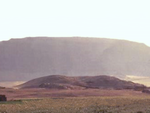
Pyramid of Ahmose
Encyclopedia

Cenotaph
A cenotaph is an "empty tomb" or a monument erected in honour of a person or group of people whose remains are elsewhere. It can also be the initial tomb for a person who has since been interred elsewhere. The word derives from the Greek κενοτάφιον = kenotaphion...
for pharaoh
Pharaoh
Pharaoh is a title used in many modern discussions of the ancient Egyptian rulers of all periods. The title originates in the term "pr-aa" which means "great house" and describes the royal palace...
Ahmose I
Ahmose I
Ahmose I was a pharaoh of ancient Egypt and the founder of the Eighteenth dynasty. He was a member of the Theban royal house, the son of pharaoh Tao II Seqenenre and brother of the last pharaoh of the Seventeenth dynasty, King Kamose...
at the necropolis
Necropolis
A necropolis is a large cemetery or burial ground, usually including structural tombs. The word comes from the Greek νεκρόπολις - nekropolis, literally meaning "city of the dead"...
of Abydos
Abydos, Egypt
Abydos is one of the most ancient cities of Upper Egypt, and also of the eight Upper Nome, of which it was the capital city. It is located about 11 kilometres west of the Nile at latitude 26° 10' N, near the modern Egyptian towns of el-'Araba el Madfuna and al-Balyana...
. It was the only royal pyramid built in this area. Today only a pile of rubble remains, reaching a height of about 10 m.
The pyramid was first examined by Arthur Mace and Charles Trick Currelly
Charles Trick Currelly
Charles Trick Currelly was a Canadian clergyman and archeologist, and the first director of the Royal Ontario Museum from 1914 to 1946....
in 1899. In 1993 Stephen P. Harvey conducted intensive excavations on the area surrounding the pyramid.
The pyramid was constructed from sand and rubble and only the usual limestone
Limestone
Limestone is a sedimentary rock composed largely of the minerals calcite and aragonite, which are different crystal forms of calcium carbonate . Many limestones are composed from skeletal fragments of marine organisms such as coral or foraminifera....
casing kept the building in shape. It had a base length of 52 m and was about 40 m high. The inclination of the sides was 60°.
It did not feature any chambers for burial. Around the pyramid were a number of temples and also a small cenotaph pyramid for his grandmother Tetisheri
Tetisheri
Tetisheri was the matriarch of the Egyptian royal family of the late 17th Dynasty and early 18th Dynasty.-Family:Tetisheri was the daughter of Tjenna and Neferu. The names of Tetisheri's parents are known from mummy bandages found in TT320....
.
External links
- Stephen Harvey Abydos
- Ahmose Pyramid at Abydos

